Ice, Fire & Mountains Transcontinental North America USA & Canada Overland Trip | Part 2 | South Dakota, Wyoming and Montana - Badlands, Yellowstone, Glacier National Park into Blackfeet Country
 |
| The Loop, Going-to-the-Sun Road, Glacier National Park, Montana |
This is the second part of our transcontinental North America overland road trip continuing from Part 1. In this episode, we start from Wall in South Dakota and drive Wyoming and Montana along the route for Badlands National Park, Mount Rushmore National Memorial, Devils Tower, Yellowstone and Going-to-the-Sun Road across Glacier National Park to reach Browning, Montana and Blackfeet Indian Reservation after numerous stops at some of the most spectacular places in the world, covering around 1,300 miles (2,100 km) in six days (map).
Wall, SD to Badlands National Park: A Journey Through Time
Leaving Wall, South Dakota, the short drive to Badlands National Park felt like entering another world. The dramatic landscape of layered rock formations, sharp peaks, and sprawling prairies is an ode to millions of years of geological history. We started at the Ben Reifel Visitor Center where we picked up maps and learned about the park's ancient fossils.
 |
| Badlands National Park (composite) |
Our exploration began with the Badlands Loop Road, a 39-mile scenic drive offering incredible vistas. Stops like Big Badlands Overlook and Panorama Point provided breathtaking views of the rugged terrain. At Fossil Exhibit Trail, we learned about the prehistoric creatures that once roamed here. Hiking the Notch Trail, with its ladder climb and views of the White River Valley, was a highlight of our time in the park.
Prairie Dogs
Prairie dogs are a common sight in Badlands National Park, adding a lively touch to the landscape.
 |
| Prairie Dog at Badlands National Park |
Prairie dogs are social creatures live in complex burrow systems called "towns," creating a network of tunnels and mounds that can be quite extensive.
American Bison
Bison are a prominent feature of Badlands National Park, roaming the grasslands and contributing significantly to the park's ecology. These massive animals are a keystone species, shaping the landscape through grazing and creating habitats for other wildlife.
 |
| A bison at Badlands National Park |
Observing a bison herd, whether they are grazing peacefully or engaged in a dust bath, is a powerful reminder of the vastness and wildness of the American West. The park actively manages its bison population, working with tribal partners to ensure the health of the herd and the ecological integrity of the park.
From the Badlands to Mount Rushmore: Faces of History
Continuing west, we made our way to the Mount Rushmore National Memorial, nestled in the Black Hills of South Dakota. The iconic faces of Washington, Jefferson, Roosevelt and Lincoln carved into granite were awe-inspiring.
 |
| Mount Rushmore |
The Presidential Trail allowed us to get close to the monument while offering unique perspectives. We spent time in the visitor center, learning about the artistry and effort involved in creating this national treasure.
Lunch at Hill City, SD
 |
| Chute Rooster, Hill City, South Dakota |
A short drive to Hill City in South Dakota brought us to the Chute Rooster, a rustic restaurant rich with Western charm. Their buffalo burgers and homemade pie were exactly what we needed before hitting the road again.
Crossing into Wyoming: Devils Tower National Monument
 |
| Devils Tower |
Crossing the South Dakota-Wyoming border, we arrived at Devils Tower National Monument, an imposing geological marvel in Wyoming. The Tower Trail looped around this massive rock column, and we marveled at its scale while spotting climbers ascending its vertical walls. The area’s spiritual significance to Native American tribes added an air of reverence to our visit. Devils Tower is the oldest National Monument in the United States.
Wyoming holds a special place in our hearts due to the wonderful A&E TV series "Longmire". While the Longmire series fictionalizes its Wyoming setting, it captures the essence of the state - its natural beauty, small-town dynamics, and cultural intersections. For fans wanting to experience the spirit of Longmire, Buffalo, Wyoming is the closest real-life counterpart. The town even hosts a "Longmire Days" festival annually to celebrate the series and its connection to the region.
Dinner and Night Halt in Sheridan, WY
 |
| The Pony Grill & Bar, Sheridan, Wyoming |
Driving through open Wyoming landscapes, we reached Sheridan in time for dinner at The Pony Grill & Bar. Their steak and craft beers were excellent, and the small-town atmosphere felt welcoming. Afterward, we settled into our accommodations in Sheridan, ready for another adventurous day.
Sheridan to Big Horn Scenic Byway: Beauty in the Wilderness
 |
| Big Horn Mountains Scenic Byway |
The next morning, we embarked on the Big Horn Mountains Scenic Byway, a picturesque route through Bighorn National Forest. The fresh mountain air and views of rugged peaks were invigorating. We stopped at the Hogback Interpretive Site, where sweeping vistas showcased the dramatic transitions between forested slopes and vast plains.
 |
| One of the Bighorn Scenic Highway pullouts, Big Horn Mountains Scenic Byway |
At Shell Falls Interpretive Site, the cascading 120-foot Shell Fall was mesmerizing. The rushing water surrounded by canyon walls was a perfect spot for photos and reflection.
Exploring Rural Wyoming: Big Horn to Cody
Driving through rural Wyoming, we passed charming small towns and wide-open spaces. In Cody, we visited the Fireworks Factory Outlet, picking up supplies to celebrate the upcoming Fourth of July. The festive mood and small-town charm made this stop memorable.
 |
| Fireworks Factory Outlet, Cody, Wyoming |
Entering Yellowstone National Park: A Natural Wonderland
From Cody, we passed the Buffalo Bill Reservoir and followed the North Fork of the Shoshone River, a route filled with dramatic views, before entering Yellowstone National Park.
 |
| Yellowstone Lake |
We explored Yellowstone Lake from the Lake Butte Overlook, marveling at the vast expanse of water surrounded by mountains. The geothermal wonders of Mud Caldron, Dragon’s Mouth Spring, Sulphur Caldron and Black Growler Steam Vent offered a preview of a surreal landscape of bubbling mud, steam and vivid colors.
 |
| Yellowstone Valley Inn |
The North Rim Drive revealed spectacular viewpoints like Lookout Point and Grand View. Highlights included the Valentine Geyser and the ethereal landscapes of Norris Geyser Basin. As night fell, we returned to Yellowstone Valley Inn & RV Park, where the clear night sky revealed the Milky Way in all its glory.
Day Two in Yellowstone: Old Faithful and More
 |
| Grand Prismatic Spring Overlook |
The next morning, we visited Old Faithful, timing our arrival to watch its iconic eruption. We explored nearby geysers like Whistle Geyser, Grumbler and White Dome Geyser. The surreal beauty of Grand Prismatic Spring was unforgettable, with its vibrant colors visible from the overlook.
 |
| Grand Canyon Of The Yellowstone: Upper Falls (Yellowstone River) |
We continued to the Grand Canyon of the Yellowstone, stopping at Hayden Valley, Mammoth Hot Springs and Lamar Valley to watch wildlife. Other highlights included Tower Fall, Lower Geyser Basin, West Thumb Geyser Basin and Terrace Spring.
 |
| Madison River |
The Madison River, a renowned trout stream, flows through the western edge of Yellowstone National Park and into Montana. This picturesque river, formed by the confluence of the Gibbon River and Firehole River, offers exceptional fly-fishing opportunities for anglers seeking trophy trout. The Madison River is known for its clear, cold water, abundant aquatic insects, and diverse fish populations, making it a favorite among experienced and novice anglers alike.
 |
| Madison River just before Seven Mile Bridge |
We drove along the Madison River crossing the Seven Mile Bridge, heading to the West Yellowstone Gate. On the way, we were fortunate to experience some great Yellowstone wildlife!
Yellowstone wolf
In a flat stretch between Terrace Spring and the Purple Mountain Trailhead, we spotted a rare Yellowstone Wolf at a waterhole. The Yellowstone wolf is a subspecies of gray wolf that was reintroduced to Yellowstone National Park in 1995 after being absent for nearly 70 years. Their return has had a profound impact on the park's ecosystem, influencing the behavior of elk and other prey species, and contributing to the recovery of riparian areas.
 |
| Yellowstone Wolf |
While the presence of wolves has sparked controversy among ranchers and some local communities, the Yellowstone wolf has become a symbol of ecological restoration and a reminder of the interconnectedness of all living things within a complex ecosystem.
Yellowstone Elk
While driving on the Grand Loop Road between Wraith Falls Trailhead and Lava Creek, we spotted some of the common elk. These large, majestic animals are a key part of the park's ecosystem. In the summer, they graze in meadows and forests, while in the winter, they migrate to lower elevations.
 |
| Elk |
Elk are a crucial food source for wolves, bears, and other predators, and their browsing helps to shape the park's vegetation. Observing elk in Yellowstone, whether it's a solitary bull bugling during the rut or a massive herd migrating across the landscape, is a truly unforgettable experience.
Yellowstone White-Tailed Deer
White-tailed deer are relatively uncommon in Yellowstone National Park compared to mule deer. They tend to inhabit areas with denser vegetation, such as riparian zones along rivers and streams. We spotted one next to the Madison River just before the Harlequin Lake Trailhead.
 |
| White-Tailed Deer |
While they are an important part of the park's ecosystem, their impact is less pronounced than that of mule deer. White-tailed deer are prey for predators like wolves and mountain lions, and they also play a role in shaping the vegetation within their preferred habitats.
We exited Yellowstone National Park via West Yellowstone Gate to spend the night at Parade Rest Guest Ranch, enjoying a hearty meal and rustic accommodations, and once again, incredibly clear skies full of stars with the cloudy Milky Way flowing across.
 |
| Parade Rest Guest Ranch, West Yellowstone, Montana |
Wyoming to Montana: Earthquake Lake and Beyond
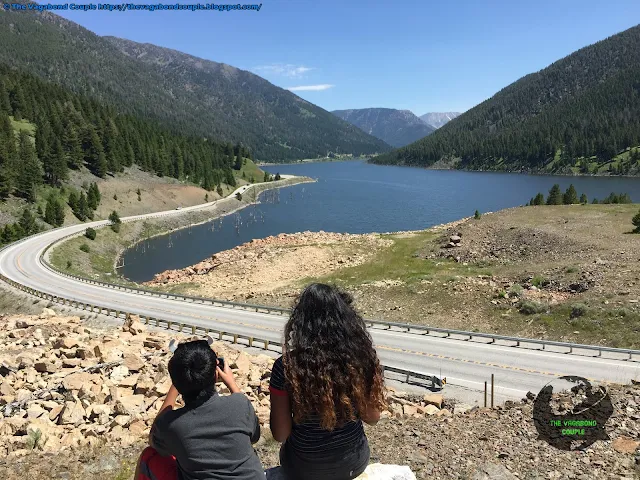 |
| Earthquake Lake, Montana |
Crossing into Montana, we visited Earthquake Lake, a hauntingly beautiful site formed after a 1959 earthquake. Driving Johnny Ridge Road, the vistas of rolling hills and mountains were stunning.
 |
| Johnny Ridge Road, Montana |
In Bozeman, we indulged in a relaxing massage at Bozeman Hot Springs, followed by shopping at the Ennis Trading Post.
 |
| Bozeman Hot Springs |
Dinner was a lively experience at a local Mongolian barbecue spot, capping off our day. We spent the night at the comfortable Microtel Inn & Suites by Wyndham Bozeman, ready for the next leg of our journey.
From Bozeman to West Glacier: Big Sky to Big Mountains
We left Bozeman early, excited for what lay ahead. Our route took us through lush valleys and winding roads before reaching the beautiful Flathead Lake, one of the largest freshwater lakes west of the Mississippi. The water was so clear it looked like glass, mirroring the pine-covered mountains surrounding it. We stopped briefly in Polson to stretch our legs and grab some cherries from a roadside stand – this area is famous for them, and they were the juiciest we’ve ever tasted!
As we continued north, we passed through Columbia Falls and Whitefish, charming towns that perfectly blend rugged mountain vibes with a laid-back, small-town feel. The views here, especially with the towering peaks of the Rockies in the background, were nothing short of postcard-perfect.
Into Glacier National Park: A Drive to Remember
 |
| West Glacier, Glacier National Park, Montana |
Entering Glacier National Park from the town of West Glacier felt like stepping into a nature documentary. The highlight of the park, and what we’d been itching to experience, was the Going-to-the-Sun Road. Words can barely capture how spectacular this drive is, but we’ll try.
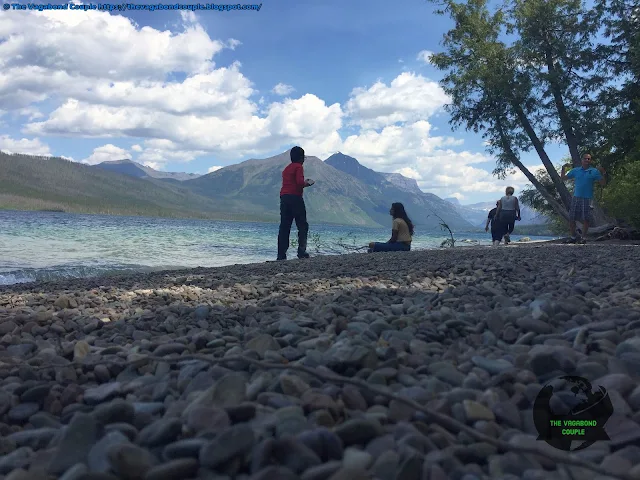 |
| Lake McDonald, Going-to-the-Sun Road, Glacier National Park, Montana |
We started near Lake McDonald, a serene expanse of water with a pebbled shoreline. The reflections of the surrounding mountains danced on the lake’s surface like a living painting. McDonald Creek, a pristine mountain stream, originates high in the park's mountains and flows into Lake McDonald, the largest lake in the park. The creek's clear, cold waters attract anglers and wildlife alike, while the lake's serene beauty and towering mountain backdrop make it a popular destination for boaters, hikers, and campers.
 |
| McDonald Creek |
At Red Rock Point, the cascading water and deep red cliffs were jaw-dropping, and Crystal Point offered some of the clearest views we’d ever seen.
 |
| The Loop, Going-to-the-Sun Road, Glacier National Park, Montana |
The road then began its climb. At The Loop, a sharp hairpin bend, we could see the road snaking both behind and ahead of us, with panoramic views of the valleys below.
 |
| The Loop, Going-to-the-Sun Road, Glacier National Park, Montana |
We stopped often to take it all in - who wouldn’t?
 |
| Alder Creek bridge on Going-to-the-Sun Road, Glacier National Park, Montana |
Alder Creek cascades through a picturesque gorge beneath Going-to-the-Sun Road, offering breathtaking views of the creek tumbling over rocks and through lush forests. The sound of the rushing water creates a soothing soundtrack for travelers as they navigate the winding curves of this renowned mountain highway.
 |
| Alder Creek Cascades, Going-to-the-Sun Road, Glacier National Park, Montana |
Grinnell Glacier and Salamander Glacier, nestled amidst towering peaks, are slowly receding due to climate change, making them poignant symbols of the impacts of global warming. Hiking to Grinnell Glacier is a popular activity, offering breathtaking views of the glacier, the surrounding mountains, and the dynamic interplay between ice, water, and rock.
 |
| Grinnell Glacier and Salamander Glacier |
Further up, Bird Woman Falls cascaded down a sheer cliff face, its mist catching the sunlight like tiny rainbows. The Crystal Point / Bird Woman Falls Overlook is a breathtaking vantage point along the Going-to-the-Sun Road in Glacier National Park, Montana. Here, visitors are rewarded with a panoramic view of the majestic Bird Woman Falls, a 560-foot waterfall that plunges into a deep gorge.
 |
| Crystal Point / Bird Woman Falls Overlook, Going-to-the-Sun Road |
The falls are framed by towering mountains, lush forests, and alpine meadows, creating a scene of unparalleled natural beauty. The sheer power of the water cascading over the cliffs, coupled with the serenity of the surrounding landscape, evokes a sense of awe and wonder in those who behold it.
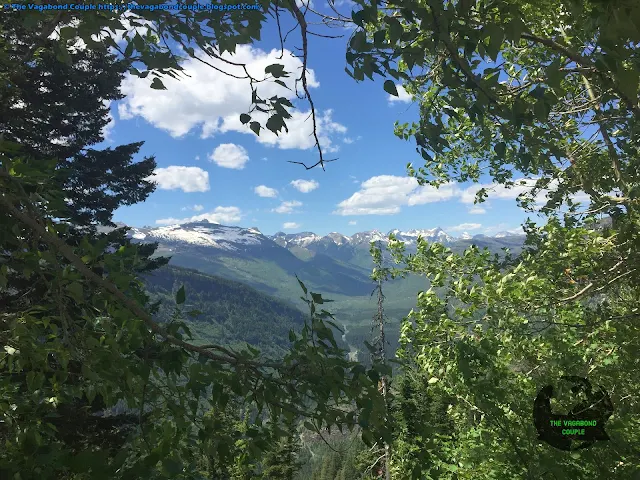 |
| Crystal Point / Bird Woman Falls Overlook, Going-to-the-Sun Road |
Whether you are a photographer seeking the perfect shot or simply a nature lover seeking a moment of tranquility, Crystal Point / Bird Woman Falls Overlook is an unforgettable experience.
 |
| Crystal Point / Bird Woman Falls Overlook, Going-to-the-Sun Road |
Then came Paradise Meadow, blanketed with wildflowers in full bloom.
 |
| Paradise Meadow, Going-to-the-Sun Road, Glacier National Park, Montana, USA |
Standing at Paradise Meadow in Glacier National Park, the view of Mount Oberlin is nothing short of breathtaking.
 |
| Paradise Meadow, Going-to-the-Sun Road |
The majestic peak rises majestically above the alpine meadows, its jagged summit piercing the clouds. The mountain's slopes are adorned with a patchwork of verdant forests, lush meadows, and glistening glaciers, creating a tapestry of colors that is both awe-inspiring and serene.
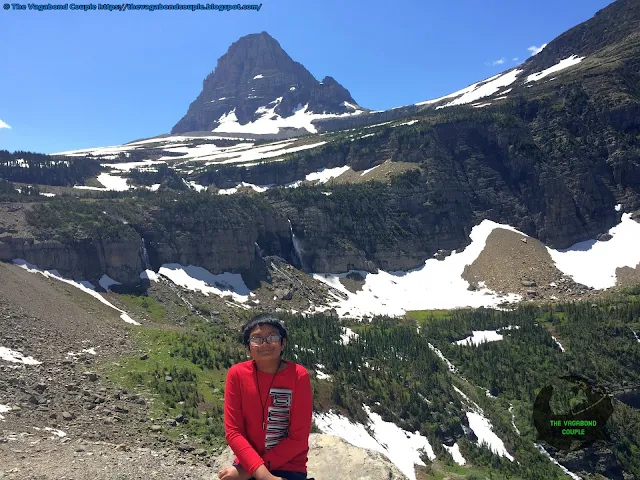 |
| Paradise Meadow, Going-to-the-Sun Road |
As the sun bathes the mountain in its golden light, the view is transformed into a scene of ethereal beauty, leaving a lasting impression on all who behold it.
 |
| Paradise Meadow, Going-to-the-Sun Road |
The Weeping Wall is a natural wonder that graces the Going-to-the-Sun Road, adding a touch of magic to the already breathtaking landscape. This geological formation is a series of seeps and waterfalls that cascade down the rock face of Haystack Butte, creating a shimmering curtain of water.
 |
| The Weeping Wall |
The sound of the water dripping and falling is soothing and meditative, creating a peaceful atmosphere that invites visitors to pause and take in the beauty of their surroundings.
 |
| Logan Pass, Going-to-the-Sun Road, Glacier National Park |
We then arrived at Logan Pass, the highest point on the road. At the pass, we parked and hiked a short trail, catching glimpses of mountain goats and marmots playing among the rocks.
 |
| Saint Mary Lake, Going-to-the-Sun Road, Glacier National Park |
The east side of the park held even more surprises. Saint Mary Lake stretched out like a shimmering blue ribbon, and the Wild Goose Island Lookout gave us one of the most iconic views of the trip.
 |
| Saint Mary Lake, Going-to-the-Sun Road, Glacier National Park |
Saint Mary Lake is a stunning gem nestled along the Going-to-the-Sun Road in Glacier National Park, Montana.
 |
| Saint Mary Lake, Going-to-the-Sun Road, Glacier National Park |
Saint Mary Lake's crystal-clear waters reflect the surrounding mountains, creating a mirror-like image that is both captivating and serene.
 |
| Saint Mary Lake, Going-to-the-Sun Road, Glacier National Park |
The lake is framed by towering peaks, lush forests, and alpine meadows, creating a landscape of unparalleled beauty.
 |
| Saint Mary Lake, Going-to-the-Sun Road, Glacier National Park |
Whether you are enjoying a leisurely stroll along the shore, taking a boat ride across the lake, or simply relaxing and admiring the scenery, Saint Mary Lake is an unforgettable experience that will leave you mesmerized.
We reached the spectacular Saint Mary Visitors' Center and then the town of Saint Mary. Having lunch at Frog's Cantina in Saint Mary was an interesting experience - a casual atmosphere and outdoor seating provided a relaxed setting to enjoy a meal with stunning views of the surrounding mountains.
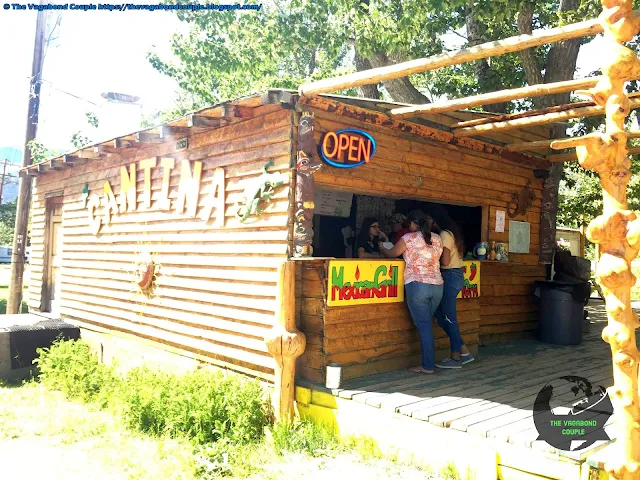 |
| Frog's Cantina in Saint Mary |
The menu features Tex-Mex favorites, from flavorful tacos and burritos to sizzling fajitas and refreshing margaritas. A delicious meal with a touch of Southwestern flair was served far from the American Southwest!
 |
| Frog's Cantina in Saint Mary |
Onto Browning, Montana: A Cultural Stop
After leaving Glacier, we followed the Blackfoot Highway to Browning, the heart of the Blackfoot Indian Reservation. This was a chance to step out of the car and dive into the area’s rich history and culture.
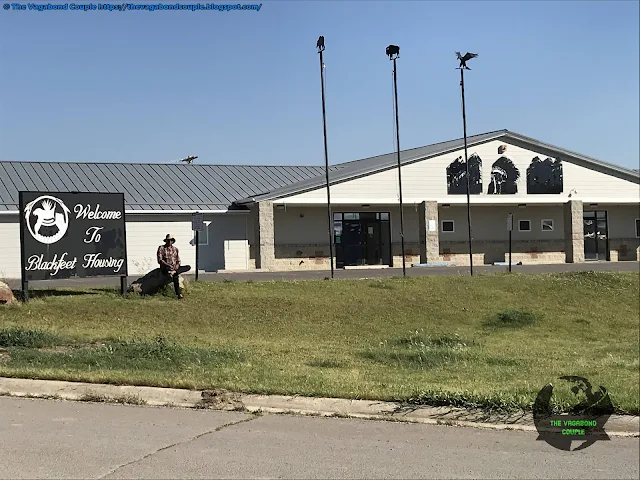 |
| Blackfeet Housing Authority Office |
The Blackfoot people, or Piikani, are part of a larger confederacy that includes several tribes across Montana, Alberta, and Saskatchewan. Historically, they were nomadic hunters, deeply connected to the bison that once roamed these plains in the millions. Their economy revolved around the buffalo, which provided everything from food to tools, clothing, and shelter.
 |
| Native Life Store |
 |
| Blackfeet Indian Reservation |
Today, the Blackfoot people are reclaiming their heritage while embracing modern opportunities. The local economy includes ranching, tourism, and traditional crafts. We were lucky enough to meet a local artist who shared the stories behind her beadwork designs, which reflect both her ancestry and the land she calls home.
This part of our journey left us in awe - not just of the natural beauty but of the history and resilience woven into the fabric of this region. As we left Browning the next day, the rising sun cast a golden glow over the plains, a fitting beginning to another unforgettable day.
Next up is Part 3, where we cross the USA - Canada international land border and head deeper into the Rockies and venture into the Columbia Icefield and Athabasca Glacier at Canada’s Banff and Jasper National Parks!






0 comments